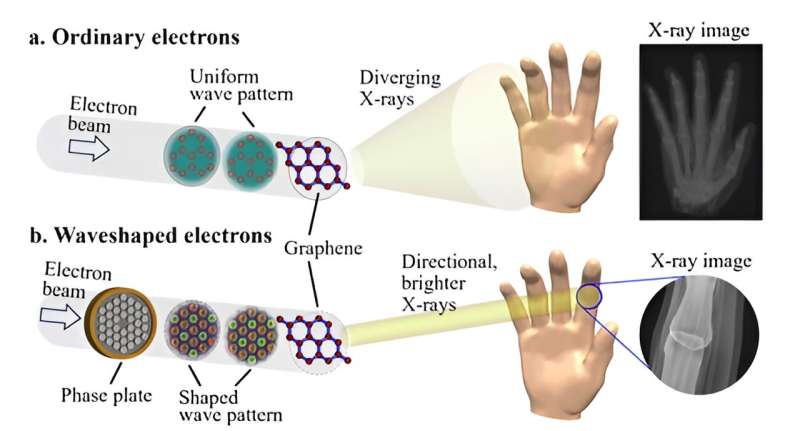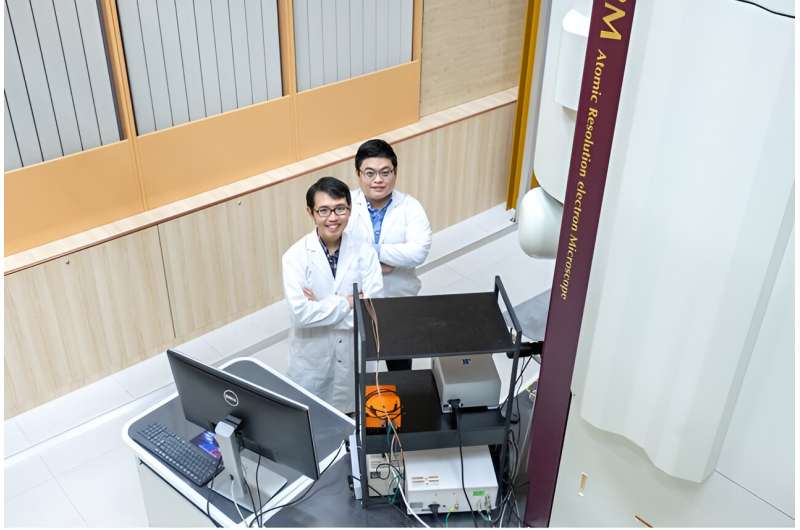This article has been reviewed according to Science X's editorial process and policies. Editors have highlighted the following attributes while ensuring the content's credibility:
fact-checked
peer-reviewed publication
trusted source
proofread
Team develops new way to generate powerful and focused X-rays using electron waveshaping

Scientists led by Nanyang Technological University, Singapore (NTU Singapore) have developed and simulated a new energy-efficient way to generate highly focused and finely controlled X-rays that are up to a thousand times more intense than those from traditional methods. The findings are published in the journal Light: Science & Applications.
This paves the way for ultra high-quality X-ray imaging that uses powerful X-rays for detecting flaws in semi-conductor chips accurately. The new method could also allow more focused X-ray imaging to be done for health screening while using less energy.
The novel method is based on computer simulations that shoot electrons at an ultra-thin material with highly ordered structures, such as graphene. The basic mechanism is similar to how X-rays are conventionally produced using X-ray tubes. But there is a twist: In the simulations, the wave-like patterns of how the electrons travel are "shaped" in a very specific way so that the particles' traveling path matches and overlaps with the highly structured positions of the material's atoms.
This theoretically results in X-rays that are emitted at much higher intensities than normal, and that can be finely controlled so that they are generated in either many different directions or in a single general direction.
Usually, when the fired electrons collide with the atoms of the material, the electrons become deflected and emit X-rays, in what is called bremsstrahlung or "braking radiation."
Bremsstrahlung contributes to most of the emitted X-rays in conventional methods of generating the radiation using X-ray tubes. But one problem is that the X-rays are not focused since they are emitted in different directions. Current methods try to address this by filtering the X-rays so that only those emitted in the desired direction are used. However, even these filtered X-rays are still fairly diffused.
An international team of scientists from the Singapore University of Technology and Design, Stanford University, Technion–Israel Institute of Technology, Tel Aviv University and the University of California, Los Angeles, led by Nanyang Assistant Professor Wong Liang Jie from NTU's School of Electrical and Electronic Engineering, developed a way to overcome these challenges in computer simulations, by changing the way the fired electrons travel.
Using computers, the scientists modeled electrons passing through a specially made plate that also has a current flowing through it to generate a voltage. The scientists were able to show in simulations that the way the electrons traveled changed after passing through such a "phase plate," an effect called electron waveshaping.
This happens because electron particles are able to travel in a wave pattern like light waves, according to quantum physics. As a result, earlier research has shown that they can interfere with one another after passing through a phase plate. The plate's voltage also causes shifts in the pattern of the electrons' wave-like movement, and adjusting the voltage can tweak the electron's wave pattern too.
The shaped electrons were then simulated to strike an ultra-thin material made of graphene about 1,000 times thinner than a strand of hair.
Due to how these electrons were shaped, the electrons' path of travel had a very high tendency to match the hexagonal positions of the atoms in graphene.

This increased the probability that the electrons would collide with the atoms and the simulations showed that more X-rays would be emitted as a result, thereby increasing the intensity of the radiation produced.
The simulations showed that the new method was more energy efficient too. Using the same amount of current to fire electrons, the X-rays produced by the researchers' method were up to a thousand times more powerful than those produced by conventional methods using X-ray tubes. The intensity of the radiation could also be adjusted by making changes to the phase plate.
Depending on what the X-rays are used for, they could be emitted in different directions or focused in one general direction with the new method, allowing future X-ray generating devices to be more tunable than before. This fine control was achieved in simulations by adjusting the voltage of the plate to change the pattern and path of how the electrons traveled.
When the electrons' wave pattern tended to overlap with the surface of whole atoms, the X-rays produced were more diffused. Tweaking the plate's voltage to cause the electrons' wave pattern to coincide instead with ring-shaped layers around the atoms generated X-rays in one general direction.
The focused X-rays were likely produced because the way the electrons interacted with atoms was changed, which resulted in interference by the X-rays that destroyed X-rays emitted in some directions while reinforcing others in one direction.
Since the new method requires less energy to produce intense X-rays, it could open the way for smaller X-ray generating devices to be made since a less powerful energy source is needed—possibly shrinking standard machines that might be larger than a house to one that could fit on a table.
While there are existing commercial instruments that can do electron waveshaping, using them to produce high-intensity and tunable X-rays is novel, as researchers in the past tried using electron waveshaping to change other types of radiation.
These previous attempts inspired the scientists led by Asst. Prof. Wong to try waveshaping X-rays in computer models to determine how outcomes changed when different parameters were adjusted. One of these simulated experiments found that changing the pattern of how electrons traveled could increase the brightness of the X-rays produced and this formed the basis of the latest research.
Potential applications of the powerful X-rays produced by the scientists' method include using them to produce very high-resolution X-ray images of semiconductor chips to detect any hard-to-see flaws in manufactured chips more accurately.
Since the X-rays produced could be controlled to be either diffused or focused, the new method could offer more flexibility in performing X-ray imaging for health screening, such as imaging an entire hand or just a finger joint, while using less energy to produce the radiation. Focused and intense X-rays might also have uses in more targeted radiotherapy to treat cancer.
The scientists are now planning to carry out experiments to confirm the results of their simulations.
Asst. Prof. Wong said, "The precision of electron waveshaping is crucial to the generated X-rays. We believe with the rapid advancement of electron-waveshaping techniques, our proposed mechanism can be fully implemented for intense and highly tunable table-top X-ray technology."
More information: Lee Wei Wesley Wong et al, Free-electron crystals for enhanced X-ray radiation, Light: Science & Applications (2024). DOI: 10.1038/s41377-023-01363-4
Journal information: Light: Science & Applications
Provided by Chinese Academy of Sciences




















